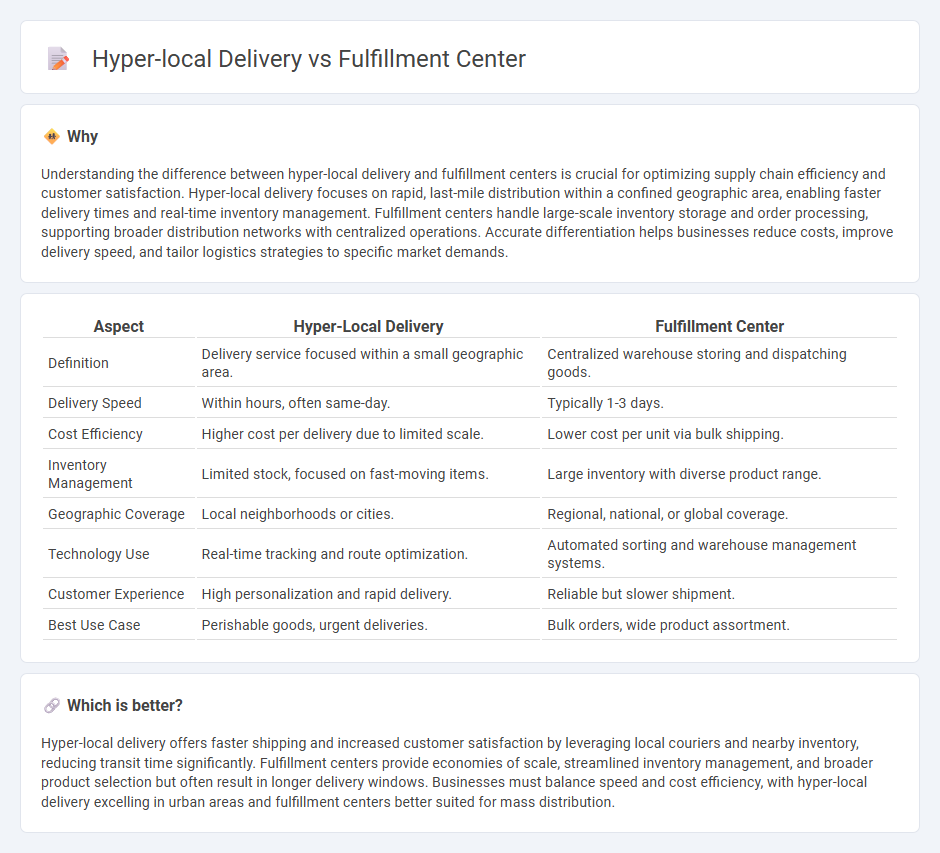
Hyper-local delivery focuses on rapid, same-day shipments within a small geographic area, leveraging local distribution centers to reduce transit times and enhance customer satisfaction. Fulfillment centers operate on a larger scale, managing inventory storage and order processing for widespread regions, prioritizing efficiency and cost-effectiveness over speed. Explore the advantages and best use cases of hyper-local delivery versus fulfillment centers to optimize your logistics strategy.
Why it is important
Understanding the difference between hyper-local delivery and fulfillment centers is crucial for optimizing supply chain efficiency and customer satisfaction. Hyper-local delivery focuses on rapid, last-mile distribution within a confined geographic area, enabling faster delivery times and real-time inventory management. Fulfillment centers handle large-scale inventory storage and order processing, supporting broader distribution networks with centralized operations. Accurate differentiation helps businesses reduce costs, improve delivery speed, and tailor logistics strategies to specific market demands.
Comparison Table
| Aspect | Hyper-Local Delivery | Fulfillment Center |
|---|---|---|
| Definition | Delivery service focused within a small geographic area. | Centralized warehouse storing and dispatching goods. |
| Delivery Speed | Within hours, often same-day. | Typically 1-3 days. |
| Cost Efficiency | Higher cost per delivery due to limited scale. | Lower cost per unit via bulk shipping. |
| Inventory Management | Limited stock, focused on fast-moving items. | Large inventory with diverse product range. |
| Geographic Coverage | Local neighborhoods or cities. | Regional, national, or global coverage. |
| Technology Use | Real-time tracking and route optimization. | Automated sorting and warehouse management systems. |
| Customer Experience | High personalization and rapid delivery. | Reliable but slower shipment. |
| Best Use Case | Perishable goods, urgent deliveries. | Bulk orders, wide product assortment. |
Which is better?
Hyper-local delivery offers faster shipping and increased customer satisfaction by leveraging local couriers and nearby inventory, reducing transit time significantly. Fulfillment centers provide economies of scale, streamlined inventory management, and broader product selection but often result in longer delivery windows. Businesses must balance speed and cost efficiency, with hyper-local delivery excelling in urban areas and fulfillment centers better suited for mass distribution.
Connection
Hyper-local delivery maximizes speed and efficiency by sourcing products directly from nearby fulfillment centers, minimizing last-mile transit distances. Fulfillment centers strategically positioned within local neighborhoods enable rapid order processing and same-day delivery capabilities. This symbiotic relationship reduces shipping costs, enhances customer satisfaction, and supports real-time inventory management for timely order fulfillment.
Key Terms
Warehouse Management
Fulfillment centers streamline warehouse management through centralized inventory storage, automation, and efficient order processing, enabling businesses to handle large volumes with accuracy. Hyper-local delivery emphasizes proximity-based warehousing, requiring real-time inventory updates and dynamic allocation to meet immediate customer demands within a limited geographic area. Explore the latest warehouse management strategies to optimize both fulfillment center efficiency and hyper-local delivery performance.
Last-Mile Delivery
Fulfillment centers streamline inventory management and bulk order processing to accelerate last-mile delivery by reducing shipping distances and enhancing distribution efficiency. Hyper-local delivery leverages nearby inventory hubs or stores to provide rapid, on-demand fulfillment within hours, catering to immediate customer needs. Explore how integrating both strategies can optimize your last-mile delivery performance and customer satisfaction.
Inventory Proximity
Fulfillment centers centralize inventory in large warehouses, optimizing bulk storage and order processing, while hyper-local delivery depends on inventory proximity to customers by utilizing small, dispersed storage points for faster delivery times. This proximity reduces last-mile delivery costs and improves customer satisfaction through quicker order fulfillment. Explore more to understand how inventory proximity shapes delivery strategies and operational efficiency.
Source and External Links
What is a Fulfillment Center and How Can it Help Your Ecommerce ... - A fulfillment center is a specialized third-party logistics (3PL) facility where sellers outsource inventory storage, order picking, packing, and shipping directly to customers or retailers, streamlining ecommerce operations and improving customer satisfaction.
Fulfillment Centers: The Powerhouse Behind Seamless eCommerce - Fulfillment centers serve as central hubs that store, process, and fulfill ecommerce orders, leveraging technology and automation to ensure timely and accurate delivery for large order volumes and enabling retailers to outsource logistics efficiently.
What Is a Fulfillment Center? Everything You Need to Know - A fulfillment center is a third-party service provider that manages inventory and processes orders using advanced warehouse technology, enabling fast, accurate picking, packing, and shipping of products for ecommerce sellers.
 dowidth.com
dowidth.com